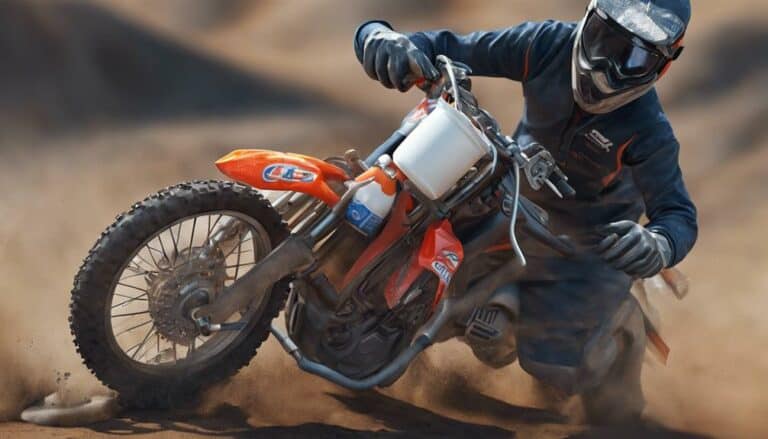As you prepare to begin on the task of changing the oil in your dirt bike, envision the serenity of a cool and quiet engine resting before the process starts.
Ensuring your safety is paramount, from donning protective gear to selecting the right tools for the job. But what about the often overlooked precautions that can make a significant difference in the outcome of your DIY oil change?
Stay tuned to discover the lesser-known safety measures that could save you from potential mishaps and keep your dirt bike running smoothly.
Key Takeaways
- Equip yourself with safety gear like gloves and eye goggles for protection.
- Elevate the bike securely to access the oil drain plug without accidents.
- Wait for the engine to cool down completely before starting the oil change.
- Prepare a proper drainage area to avoid contamination and spills during the process.
Safety Gear and Clothing
When preparing for a DIY dirt bike oil change, make sure you're equipped with the necessary safety gear and clothing to protect yourself from potential hazards. Before diving into changing the oil, make certain you have protective gloves and eye goggles to shield yourself from oil spills and splashes. Closed-toe shoes or boots are vital to guard your feet against hot oil and sharp objects. Opt for long sleeves and pants to protect your skin from engine heat and potential leaks.
Consider using a face mask or bandana to shield your nose and mouth from inhaling fumes or oil particles during the process. Having a fire extinguisher nearby is essential in case of accidental spills or ignition of flammable materials.
Proper Bike Elevation
To assure a stable and secure work environment, elevate your dirt bike on a dependable stand or lift before commencing the oil change process. Proper bike elevation is important for easy access to the oil drain plug and to prevent accidents.
Choose a stable stand that can support the weight of your dirt bike to avoid tipping over while you work. This precaution not only reduces the risk of injuries but also helps prevent oil spills during the oil change.
Working on your bike without proper support or on unstable surfaces can lead to mishaps and make the process challenging. Following recommended safety guidelines for bike elevation guarantees a smooth oil change procedure and minimizes the chances of damaging your bike.
Always prioritize your safety and the integrity of your dirt bike by using a stable stand or lift to elevate it securely before starting the oil change.
Engine Cooling and Inspection
For perfect safety and efficiency during a DIY dirt bike oil change, make sure the engine has completely cooled down before proceeding with the process. This important step prevents burns and guarantees a safe working environment.
Before starting, conduct a thorough inspection of the engine for any leaks, damage, or loose components that may require attention. It's essential to wear protective gloves and eyewear to shield yourself from hot engine parts, oil spills, and potentially harmful chemicals.
Additionally, place your dirt bike on a stable and level surface to prevent accidental tipping or movement while working on the oil change. Have a fire extinguisher within reach as a precautionary measure in case of unexpected oil spills or ignition risks during the process.
Drainage Area Preparation
Prepare the drainage area by ensuring the dirt bike is positioned on a stable and level surface to prevent any accidental spills or tipping while draining the oil. Here are three essential steps to take for effective drainage area preparation:
- Clear Debris: Before starting the oil change process, make sure the area around the drain plug is free of any debris. This will help prevent contamination of the oil being drained from the bike.
- Use a Drain Pan: Have a suitable drain pan or container ready with enough capacity to hold all the oil that will be drained from the bike. This will help in collecting the old oil efficiently without any spills.
- Wear Protective Gear: Prior to beginning the oil change, wear protective gloves and eyewear. This safety gear will shield you from potential contact with hot oil and any splashes that may occur during the draining process.
Oil Disposal and Cleanup
When disposing of old oil and cleaning up after the oil change, ensure proper containment and adherence to environmental regulations. Use a designated oil pan or container to collect the old oil for proper disposal.
It's important not to pour used oil down the drain or on the ground to prevent environmental damage. Clean up any oil spills or drips immediately using an absorbent material like cat litter or rags.
Check local regulations or recycling centers for guidelines on how to dispose of used oil safely. Remember to wear gloves and protective clothing to avoid skin contact with used oil during cleanup.
Proper disposal of oil is essential to prevent harm to the environment, so always follow safety precautions and use the appropriate absorbent materials. By disposing of oil responsibly and following local regulations, you can contribute to protecting the environment and keeping your workspace clean and safe.
Conclusion
To sum up, remember to carefully follow the recommended safety precautions when completing a DIY dirt bike oil change.
Make sure you're properly equipped with safety gear and clothing, elevate the bike correctly, cool the engine, prepare the drainage area, dispose of the oil properly, and clean up any spills promptly.
By taking these precautions seriously, you can guarantee a trouble-free oil change process and maintain the longevity of your dirt bike engine.

